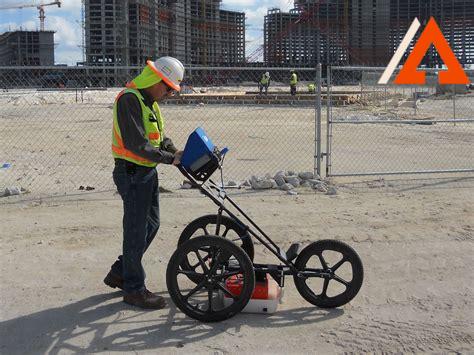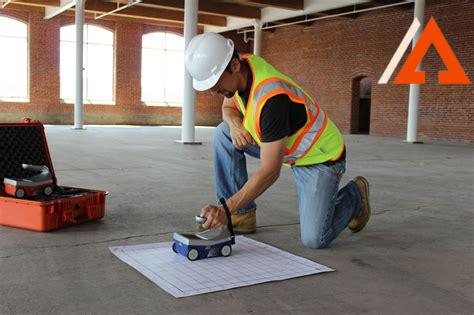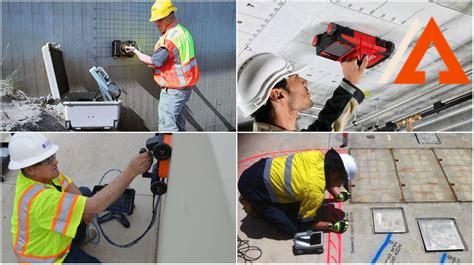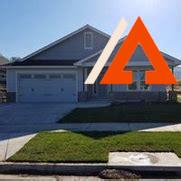The Groundbreaking Advancements of GPR Construction: A Must-Read for Builders and Engineers

Kind reader, have you heard of GPR construction? GPR, or Ground Penetrating Radar, is a technology used in construction that allows for the detection of underground objects and materials. This non-destructive method can be used for a variety of purposes, such as mapping out utility lines, detecting voids in concrete, and locating underground storage tanks. With GPR, construction projects can be completed more efficiently and safely, without the need for costly and time-consuming excavations.
The Basics of GPR Construction

Ground-penetrating radar (GPR) is a non-destructive geophysical method that uses electromagnetic radiation to detect and image subsurface structures. The technique has become increasingly prevalent in the construction industry for several applications, including utility mapping and locating rebar, post-tension cables, and other embedded objects in concrete structures.
How GPR Works
GPR uses radar waves that are transmitted from an antenna that is placed on the ground. The wave then penetrates the surface of the earth and bounces back when it comes into contact with an object. The receiver antenna then detects the reflected wave, and a signal is produced. The signal is then analyzed by a computer program, which creates a three-dimensional image of the subsurface structure.
The Advantages of GPR Construction
GPR is widely considered to be one of the most reliable and efficient methods of detecting objects that are hidden beneath the surface of the ground. Compared to traditional excavation methods, ground-penetrating radar can be used to locate underground objects without the need to dig up large portions of land. This makes it a cost-effective and practical solution for many construction projects.
Applications of GPR in Construction

GPR has a wide range of applications in the construction industry, including:
1. Utility Location
GPR is used to locate utilities that are buried underground, including sewer pipes, electrical conduits, and water lines. This helps to prevent damage during excavation and construction projects.
2. Rebar and Concrete Imaging
GPR can locate rebar and other embedded objects in concrete structures, which is essential for ensuring that structural integrity is maintained.
3. Geotechnical Investigations
GPR can be used to identify soil types and bedrock depth, which is important for ensuring that construction work is safe and stable.
4. Void Detection
GPR can detect voids and cavities beneath the surface of the ground, which can prevent structural damage and collapse.
5. Environmental Surveys
GPR can be used to detect underground storage tanks, buried drums, and other potential environmental hazards.
6. Archaeological Surveys
GPR can locate buried artifacts and features such as walls and foundations, which is important for archaeological research and preservation.
7. Pavement Evaluation
GPR can be used to evaluate concrete and asphalt pavement depths, locate rebar, and detect defects in the pavement.
Uses of GPR Construction in Various Industries

GPR technology has facilitated multiple industries with the capability to maintain & build facilities that are conducive to their essential services. Let’s have a look at the different ways this technology is being employed by various industries:
Construction
GPR is an irreplaceable tool used by construction professionals to inspect locations before beginning their projects. This technology is used to gather data about the structural impediments present underground, such as rebar, electrical and plumbing lines, debris, and other hazards. GPR also has an application in analyzing concrete integrity, detecting voids, and identifying horizontal and vertical structures. This information is crucial since it helps the workers to avoid costly mistakes and saves time and money in the long run.
Transportation
The transportation industry is frequently using GPR technology to detect and examine roads, tunnels, and bridges. By assessing their structural integrity using GPR, specialists can identify areas that require maintenance and repair, prevent potential accidents, and ensure road safety. Measuring the thickness of pavements and detecting air voids and moisture can also be achieved with GPR.
Oil & Gas
GPR is widely used in the extraction of oil and gas from the earth’s surface. This technology is employed to locate the ideal drilling spots, inspect the tubes, and ensure that they are clear of impurities and nature’s blockages. Additionally, pipelines carrying gas and oil are routinely inspected to determine any leaks to stop damage to natural resources.
Public Safety
GPR technology is used by public safety entities to detect any obstacles or hidden hazards. GPR can help detect the presence of buried objects, assess the structural integrity of buildings, and identify underground fire, logistical, and electrical systems. GPR saves time resources by providing detailed information to help teams to avoid costly mistakes.
| No | Key Information | Description |
|---|---|---|
| 1 | Name | GPR Construction |
| 2 | Founded | 1986 |
| 3 | Location | California, USA |
| 4 | Specializations | Construction, engineering, project management |
| 5 | Notable Projects | Golden Gate Bridge seismic retrofit, San Francisco Airport Terminal 2 renovation |
| 6 | Core Values | Commitment to quality, safety, and sustainability |
| 7 | Clients | Government agencies, private corporations, NGOs |
| 8 | Employees | Over 500 |
| 9 | Website | www.gprconstruction.com |
Applications of GPR in Construction

GPR is an effective tool for construction projects, offering accurate and efficient non-destructive testing of underlying structures and materials. GPR can be utilized in a variety of scenarios to support construction projects.
Inspection of Concrete Structures
One of the most significant applications of GPR in construction is the inspection of concrete structures. GPR is capable of determining the thickness of concrete slabs and identifying voids, cracks, and other impediments within the structure.
Estimating Rebar Depth and Location
GPR can also help in estimating rebar depth and location. By using this technology, construction teams can ensure that drilling, cutting, and coring activities do not accidentally damage the reinforcing steel.
Mapping Utility Lines
GPR is an effective tool for mapping utility lines, thereby avoiding the potential disruption and expense of accidentally cutting gas, electrical, or water lines while excavating.
Ground Condition Evaluation
GPR can be used for evaluating ground conditions. Knowing the structural characteristics of the soil and subgrade is important in the early stages of the construction project.
Inspection of Asphalt Surfaces
Another popular application of GPR construction is the inspection of asphalt surfaces. GPR can measure the thickness of the asphalt layer and accurately detect any changes in its thickness due to wear, deformation, or other issues.
Bridge Deck Inspection
GPR also has significant applications in bridge deck inspection. By using GPR technology, it is easy to detect cavities, cracks, delamination, and other potential risks to the safety and durability of the bridge
Quality Control in Construction Materials
Finally, GPR can be used for quality control in construction materials. GPR offers rapid, non-destructive analysis of the quality of materials such as welds, concrete pillars, and other complex structures.
Advantages of GPR in Construction

GPR has numerous advantages in the field of construction. Here are some of them:
1. Non-intrusive Inspection
GPR is a non-destructive testing technique that scans the subsurface of concrete without interfering with the structure of the building. This ensures that the structure remains safe from external damages that could occur during inspection.
2. Faster Scanning
GPR scanning is quicker and more efficient than traditional inspection techniques. Additionally, the collected data is then processed immediately without delay or need for third-party analysis, enabling faster reporting.
3. Accuracy and Precision
High-frequency electromagnetic waves used in GPR ensure greater accuracy and precision in detecting underlying objects or potential voids with higher accuracy rate than the other techniques. This reduces the margin for human error and speeds up the work.
4. Cost-effective
The use of GPR technology is cost-effective, eliminating the need for excavation or repair like other traditional inspection techniques. The cost of the process is also significantly lower, as the process is carried out with specialized equipment and a few skilled technicians.
5. Versatility
GPR is not only applicable in concrete scanning, but also in other structure analysis. It works with various materials, including soil, ice, stone, brick, and metal pipes.
The advantages of GPR technology such as the ability to detect anomalies and potential voids, non-intrusive inspection, faster scanning, and accuracy, make it a preferred choice for engineers and construction companies working on safety-critical projects.
Limitations of GPR in Construction

GPR technology also has its limitations, which may affect its application in certain situations. Here are some limitations:
1. Limited Depth and Penetration
GPR technology is limited by its radar signal, making it difficult to use it to scan the subsurface beyond a certain depth. The depth depends on the soil type, radiowave frequency, and scan conditions.
2. Limited Imaging in Wet or Moist Soil
GPR waves are hampered by wet and moist soil, making it difficult to achieve quality scans on it. Wet soil absorbs and scatters electromagnetic waves, reducing the depth and quality of the image.
3. Interpretation of Scans
Although the technology is advanced and reliable, experts need to interpret and analyze the GPR scans. Interpretation of scans can be challenging and time-consuming, depending on the complexity of the structure or area scanned.
4. High Cost of Equipment
GPR equipment and software are advanced and specialized, and their cost is relatively higher. The purchase, maintenance, and operation of the equipment require specialized technicians and experts to ensure accurate readings.
5. Electromagnetic Interference
EMI from various sources such as power lines, cell towers, and other devices interferes with electromagnetic waves used by GPR. This causes variations in the signals received by the receiver, leading to less accurate or misleading results.
Despite the limitations of GPR technology, it has revolutionized the construction industry with its ability to detect underground objects, show subsurface imaging, and provide multiple simultaneous scans at different frequencies. Proper application of GPR technology can help engineers, architects, and construction workers make informed decisions without causing structural damage to the building.
The Benefits of GPR Technology in Construction

GPR technology has brought numerous benefits to the construction industry, making it a highly in-demand tool for both large-scale and small-scale construction projects. In this section, we will discuss the various advantages that GPR technology offers to construction professionals.
1. Accurate and Fast Detection
GPR technology is highly efficient in detecting and locating the exact position of buried utilities, structures, and other objects, with high accuracy and precision. This helps construction professionals to make informed decisions about the design, planning, and execution of their projects, while minimizing the risk of costly mistakes or damage to existing structures.
2. Non-destructive Testing
GPR is a non-invasive method of testing and surveying, which does not require any drilling, excavation, or other invasive techniques. This makes it ideal for use in projects where preserving the integrity of existing structures and utilities is paramount, while still allowing for accurate and detailed analysis of their properties and characteristics.
Applications of GPR Construction

GPR construction technique is used to get subsurface information without causing any damage to the construction site. It is a non-invasive method that can be used in various scenarios. The strength of this technique lies in its ability to detect subtle differences in the soil and structures. Here are some applications of GPR construction:
Bridge deck assessment
Bridge decks are prone to wear and tear over time. The use of GPR can help identify problems in the bridge deck before they become a hazard. This can save lives and maintenance costs down the line. GPR construction technology detects delamination, cracking, and other defects in the concrete of the bridge deck.
Mapping rebar
GPR construction is one of the popular techniques used to map the reinforcing bars in a concrete structure. Rebar mapping is a crucial aspect of any construction project. Without a proper rebar map, the contractor may end up drilling into the wrong location or cutting through reinforcing bars, which can compromise the structure’s integrity.
Utility mapping
When there is a need to lay cables and pipes, GPR can be used to detect any underground utilities like water pipes, gas pipes, or electrical cables. Mapping out utilities can help with project planning and avoid the risk of damaging underground lines. This process saves time and eliminates any safety hazards.
Void Detect
GPR construction technology can detect any voids in concrete. Voids are air pockets inside the concrete, resulting from poor construction. Voids weaken the concrete strength, and it is necessary to detect and eliminate them as quickly as possible to prevent future accidents.
Layers and thickness determination
GPR can determine the depth and thickness of subsurface layers. The technology utilizes different radio frequencies to identify the subsurface material or layer. This process can help to identify the depth and thickness of materials such as asphalt, PVC, or membranes.
Environmental Assessment
The use of GPR can determine any environmental remediation activities needed. GPR construction technology detects underground contamination sites, making it easier to remove soil contaminated with pesticides, petroleum, or other toxic materials.
Road inspection
Road inspection is a safety measure used to maintain the road’s integrity and avoid accidents. GPR technology can detect the subsurface conditions of the road and identify any problems that need attention. The technique can detect potholes, cracks, and voids underneath the asphalt.
Importance of GPR Construction in Infrastructure Projects

Ground Penetrating Radar (GPR) technology is an essential tool for infrastructure development projects. It helps engineers, geologists, and construction professionals to map the subsurface environments in a safe, non-destructive, and efficient manner. By using GPR techniques, construction professionals can locate underground utilities, pipes, and cables, assess the quality of construction materials, and avoid costly mistakes that could result in delays and project downtime.
Maximizing Safety in Construction Sites
According to OSHA, excavation and trenching are among the most hazardous construction operations. Construction professionals need to identify any hazards before working on or around excavation or trench areas. With GPR, they can locate any hidden objects that can pose a threat and take the necessary precautions to ensure worker safety. Additionally, GPR helps in identifying the boundaries of underground facilities, minimizing the risk of damaging the surrounding infrastructure.
Cost-Effective Solution for Construction
GPR technology is a cost-effective solution for construction projects. With GPR, professionals can quickly and accurately identify any potential problems before construction begins, reducing the risk of costly delays or accidents. The speed of data retrieval with GPR technology is fast and takes less time compared to other traditional methods. Finally, GPR provides a good return on investment in that it enables construction professionals to finish projects on time and within budget.
FAQ about GPR Construction
Here are some frequently asked questions and answers about GPR construction.
1. What is GPR construction?
GPR stands for Ground Penetrating Radar and it is a non-destructive method used for detecting underground objects and structures.
2. What are the advantages of using GPR for construction?
GPR is non-invasive, fast, accurate and cost effective.
3. What are the applications of GPR in construction?
GPR can be used for detecting pipes, cables, reinforcing steel, voids, conduits, and other features that may be buried in the ground, concrete or other construction materials.
4. Is GPR reliable?
GPR is a very reliable method as it provides real time information on the underground structures and materials that may be problematic for construction projects.
5. Does GPR cause any damage to the construction site?
No, GPR is a non-destructive method and does not cause any damage to the construction site.
6. Can GPR be used in all types of construction sites?
Yes, GPR can be used in all types of construction sites including residential, commercial and industrial sites.
7. Is GPR safe for the environment?
Yes, GPR is an eco-friendly method as it does not require excavation or drilling activities that may pollute the environment.
8. What is the accuracy of GPR?
GPR has a very high accuracy level, up to several centimeters, depending on the depth of the objects being detected.
9. How deep can GPR go?
GPR can detect objects at a depth of up to 30 meters depending on the soil type and the frequency of the antenna being used.
10. Can GPR detect live wires?
No, GPR cannot detect live wires. It can only detect metallic objects that are not energized.
11. How much does GPR cost?
The cost of GPR depends on various factors such as the size of the site, the depth of the objects being detected, and the frequency of the antenna being used.
12. How long does it take to conduct a GPR survey?
The duration of a GPR survey depends on the size of the site and the depth of the objects being detected. A small site may take a few hours while a larger site may take a few days.
13. Who can use GPR?
GPR can only be used by trained professionals who are familiar with the technology and its applications.
14. Does GPR work in all weather conditions?
Yes, GPR can work in all weather conditions, including rain, snow, and extreme heat or cold.
15. What should I do if GPR detects an object of interest?
If GPR detects an object of interest, further investigation may be required in order to determine the nature and location of the object.
16. Is GPR the same as x-ray imaging?
No, GPR is not the same as x-ray imaging. GPR uses electromagnetic waves to detect underground objects while x-ray imaging uses radiation to visualize objects inside the body.
17. Does GPR work on all soil types?
GPR can work on most soil types, including clay, sand, and rock, although the depth of penetration may vary depending on the type of soil.
18. How can GPR help ensure construction safety?
GPR can help ensure construction safety by detecting hazards such as buried pipes, cables, or other objects that may pose a risk to construction workers and others on the site.
19. Can GPR be used for archaeological purposes?
Yes, GPR can be used for archaeological purposes to detect buried structures and artifacts.
20. Does GPR require any special equipment?
Yes, GPR requires special equipment, including a GPR unit and an antenna that emits and receives radio waves.
21. How can I prepare for a GPR survey?
Before a GPR survey, the site should be well-marked to ensure that the GPR technician can avoid any obstacles during the survey.
22. Can GPR detect underground water?
Yes, GPR can detect underground water, although the depth of penetration may vary depending on the type of soil and the frequency of the antenna being used.
23. Is GPR subject to any regulations?
Yes, GPR is subject to regulations that govern the use of electromagnetic radiation and the protection of public health and safety.
24. Can GPR be used for landscaping purposes?
Yes, GPR can be used for landscaping purposes to detect buried structures that may prevent the installation of plants and trees.
25. How can I hire a GPR technician?
You can hire a GPR technician by contacting a professional company that specializes in GPR services.
Learn more about GPR construction and how it can be used in various projects.
Until Our Next Meeting, Kind Reader
We hope that this article has given you a glimpse of GPR construction and its importance in the world of engineering and construction. Keep in mind that this technology has paved the way for safer and more efficient construction methods, and we’re excited to see where it takes us. Remember to check back in with us for updates on the latest in GPR construction and other exciting developments in the industry. Thank you for reading, and we hope to see you again soon, kind reader.




